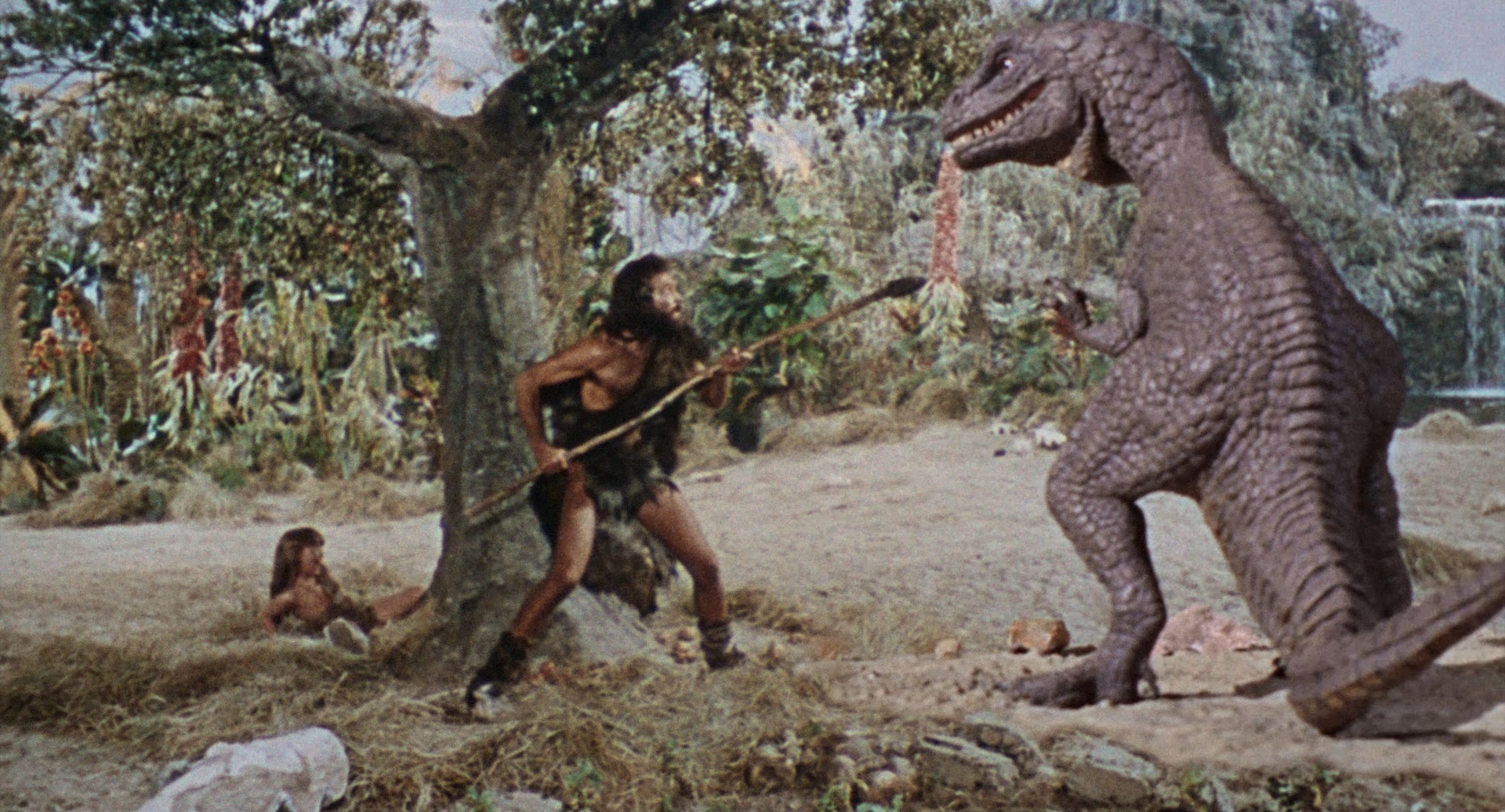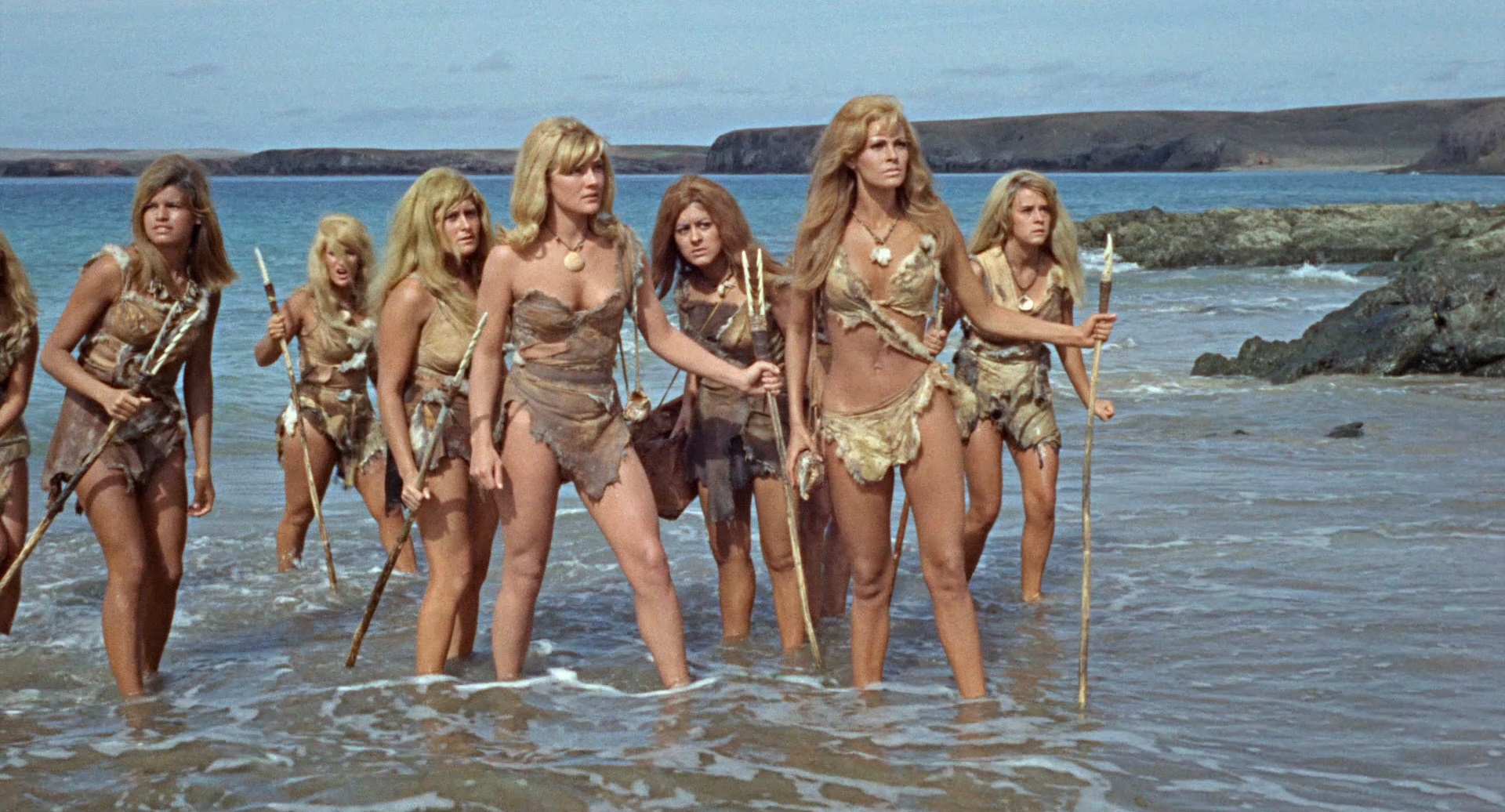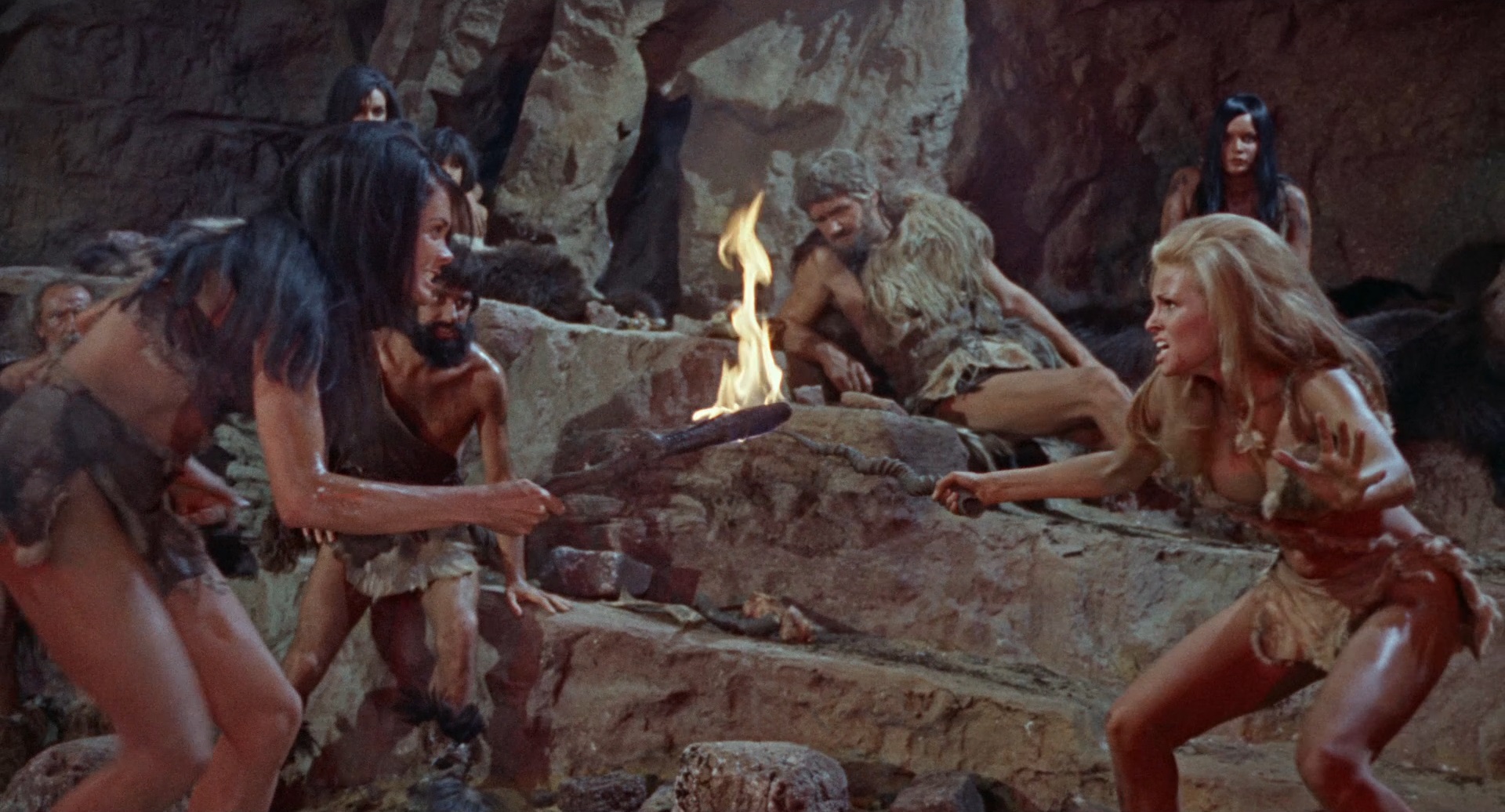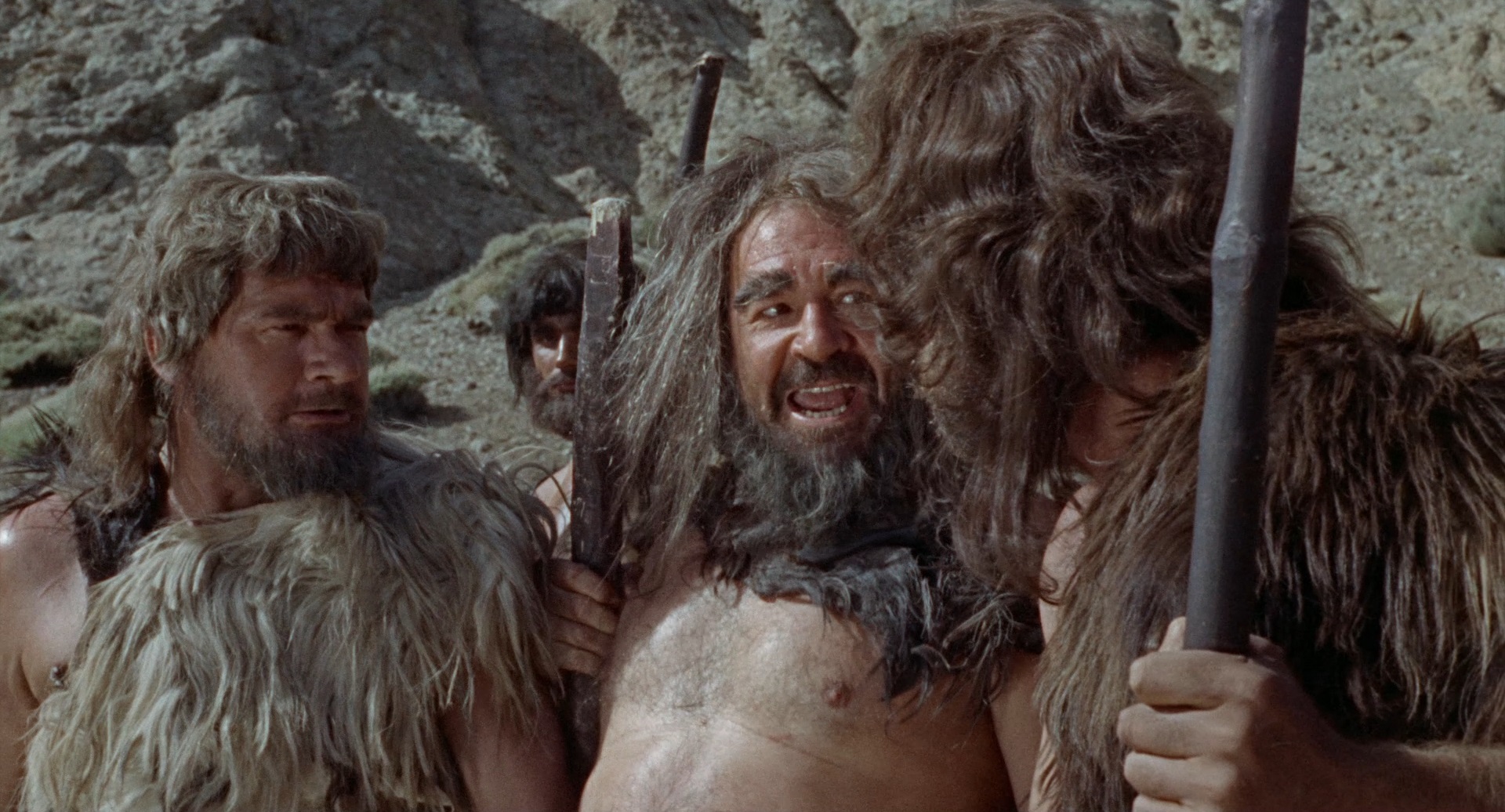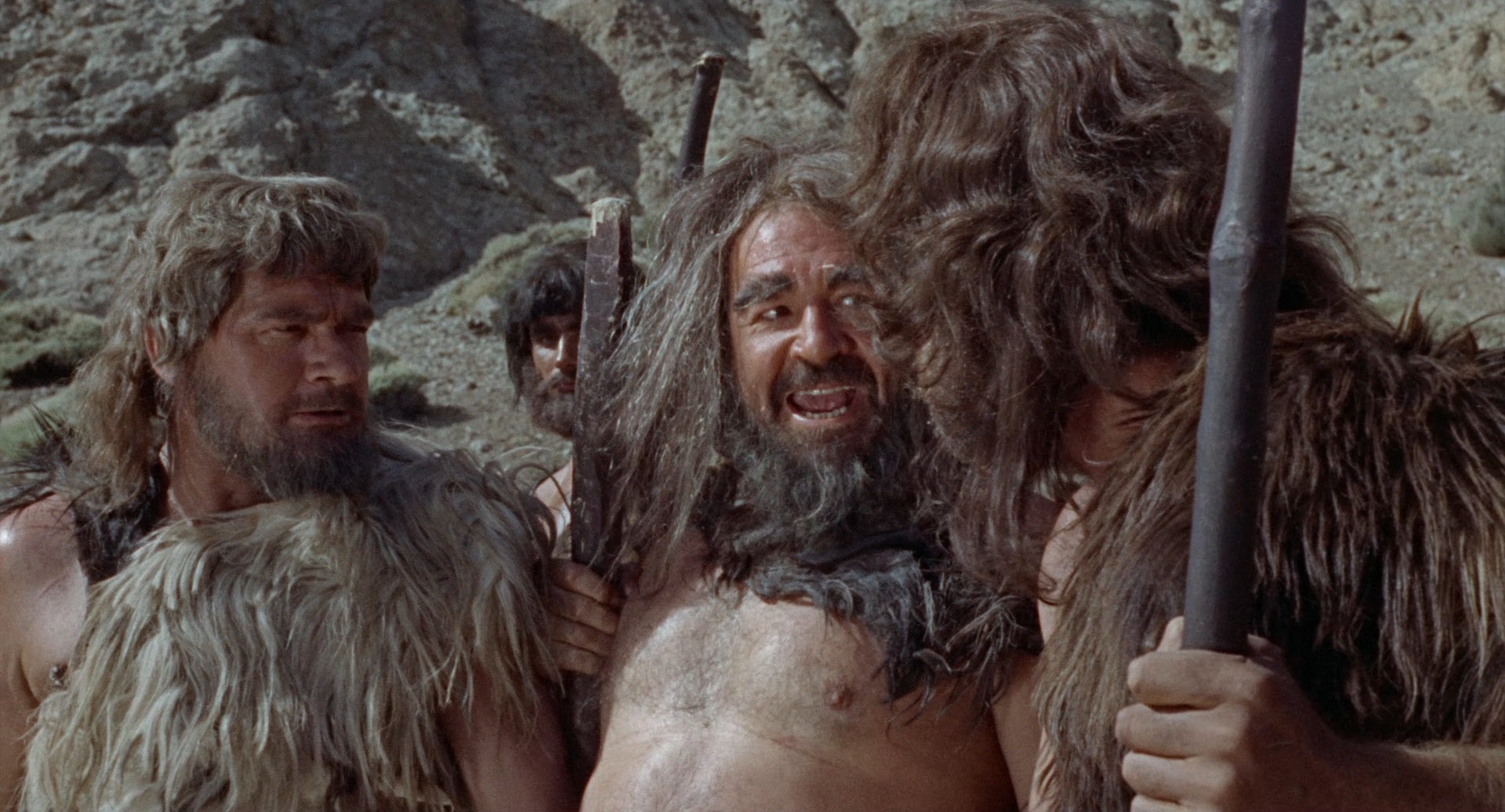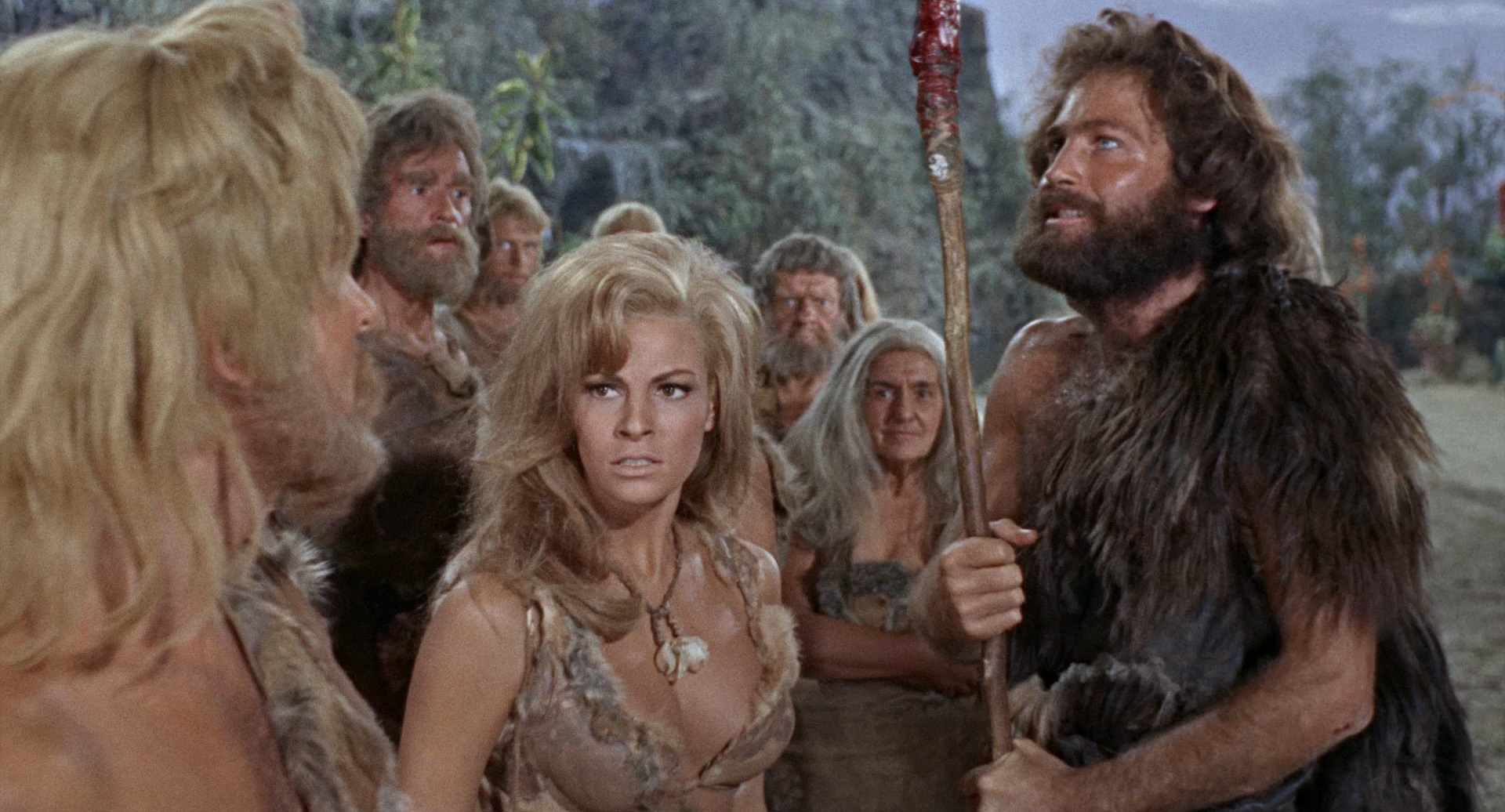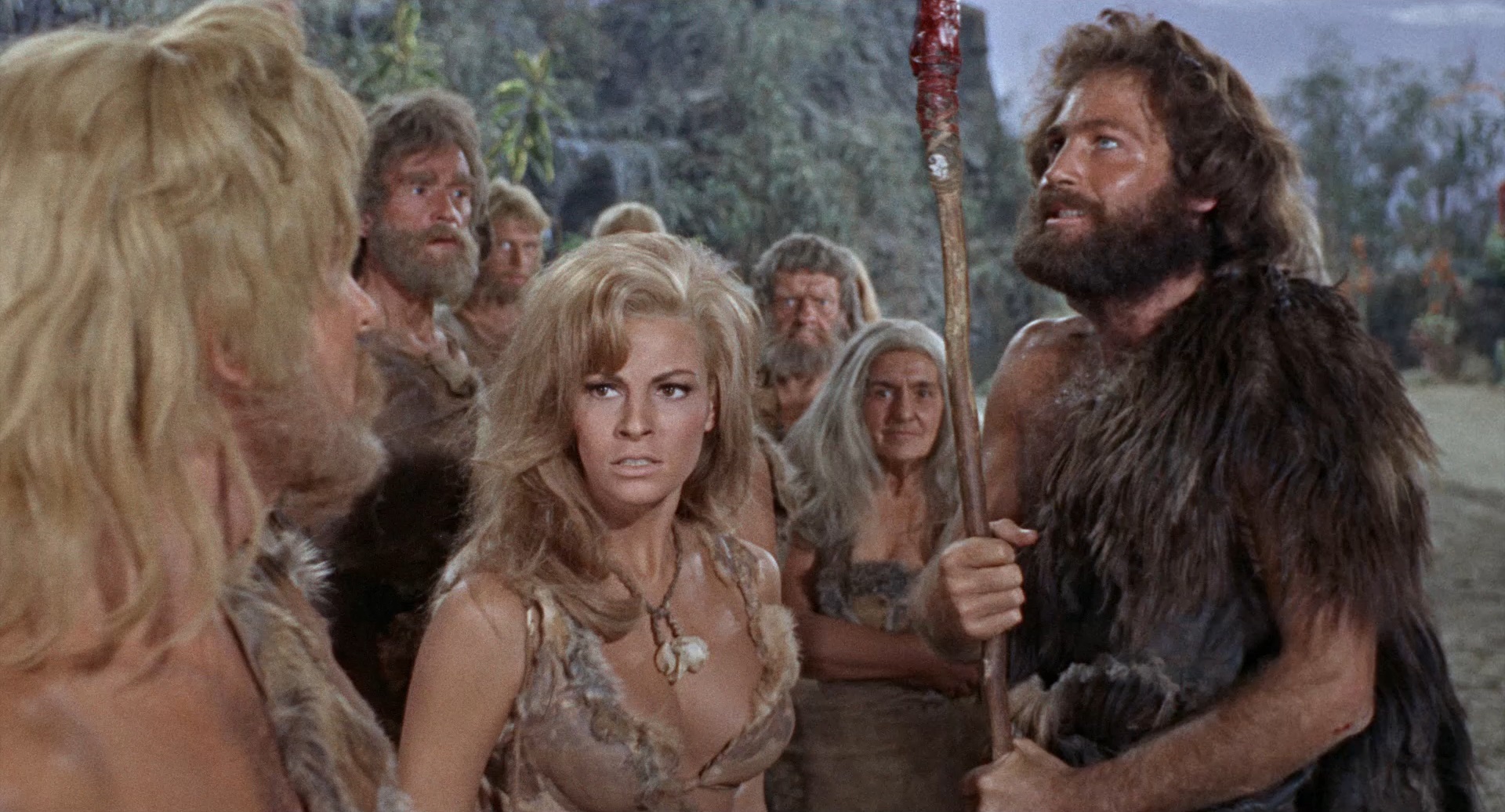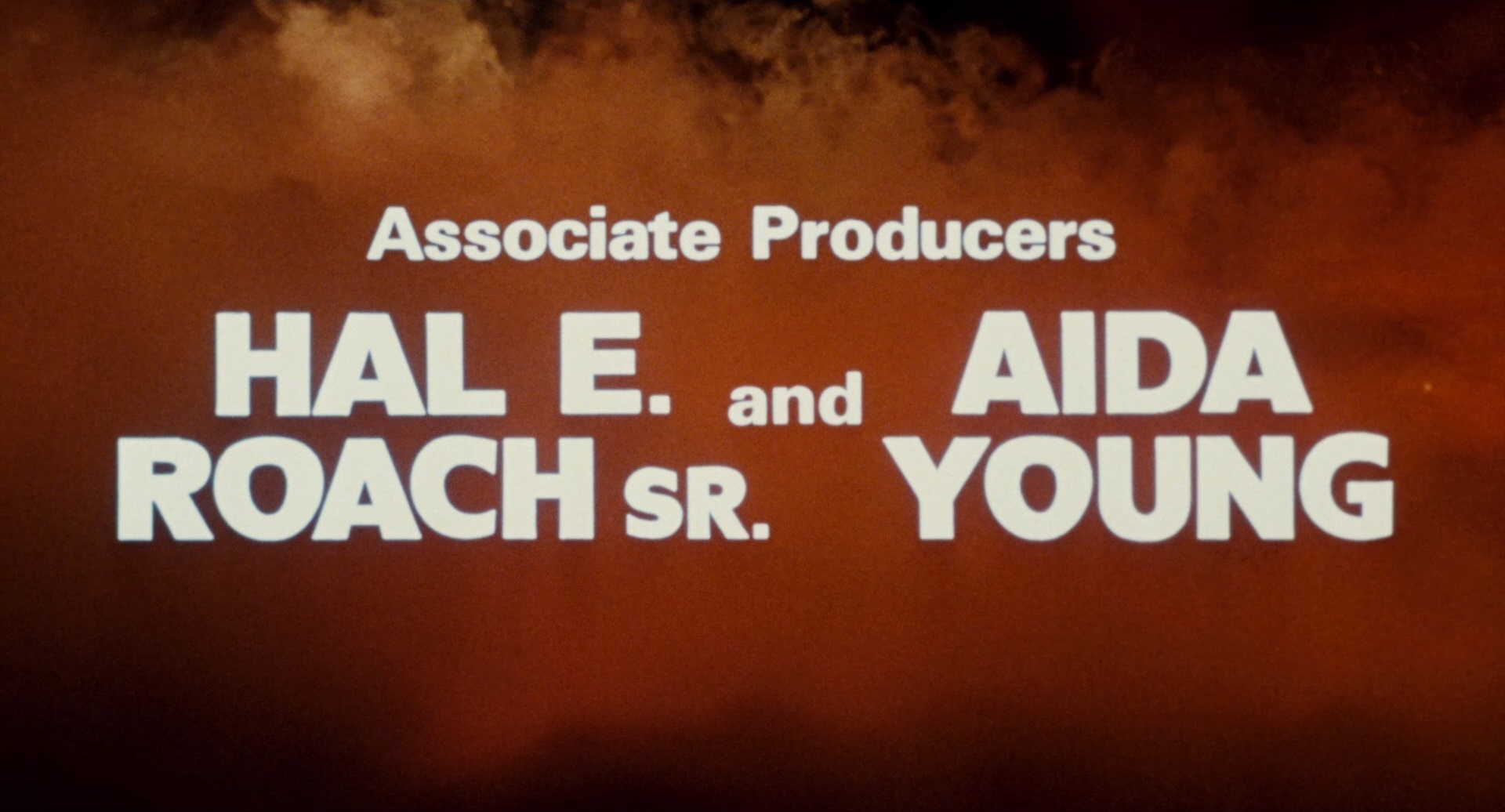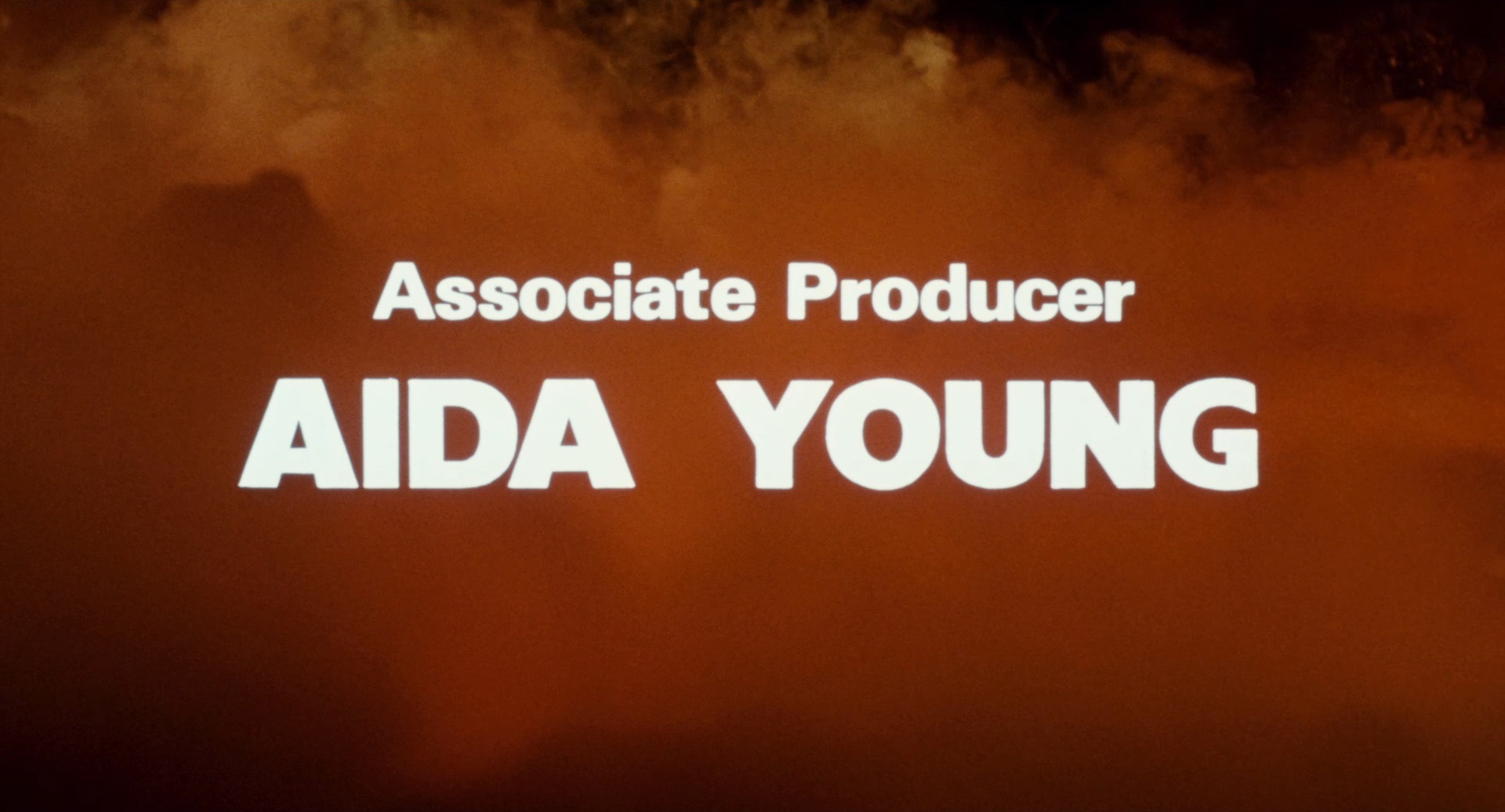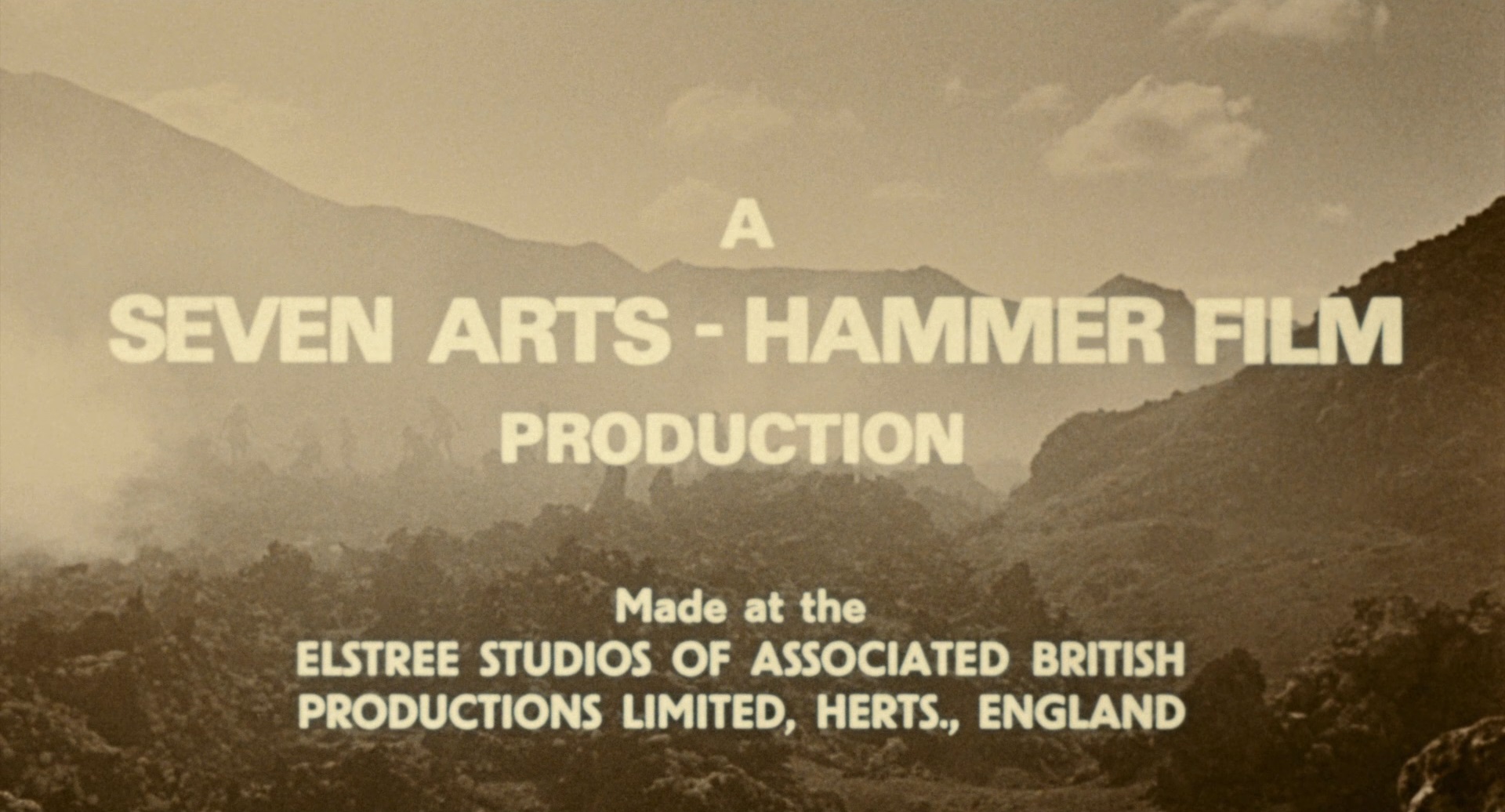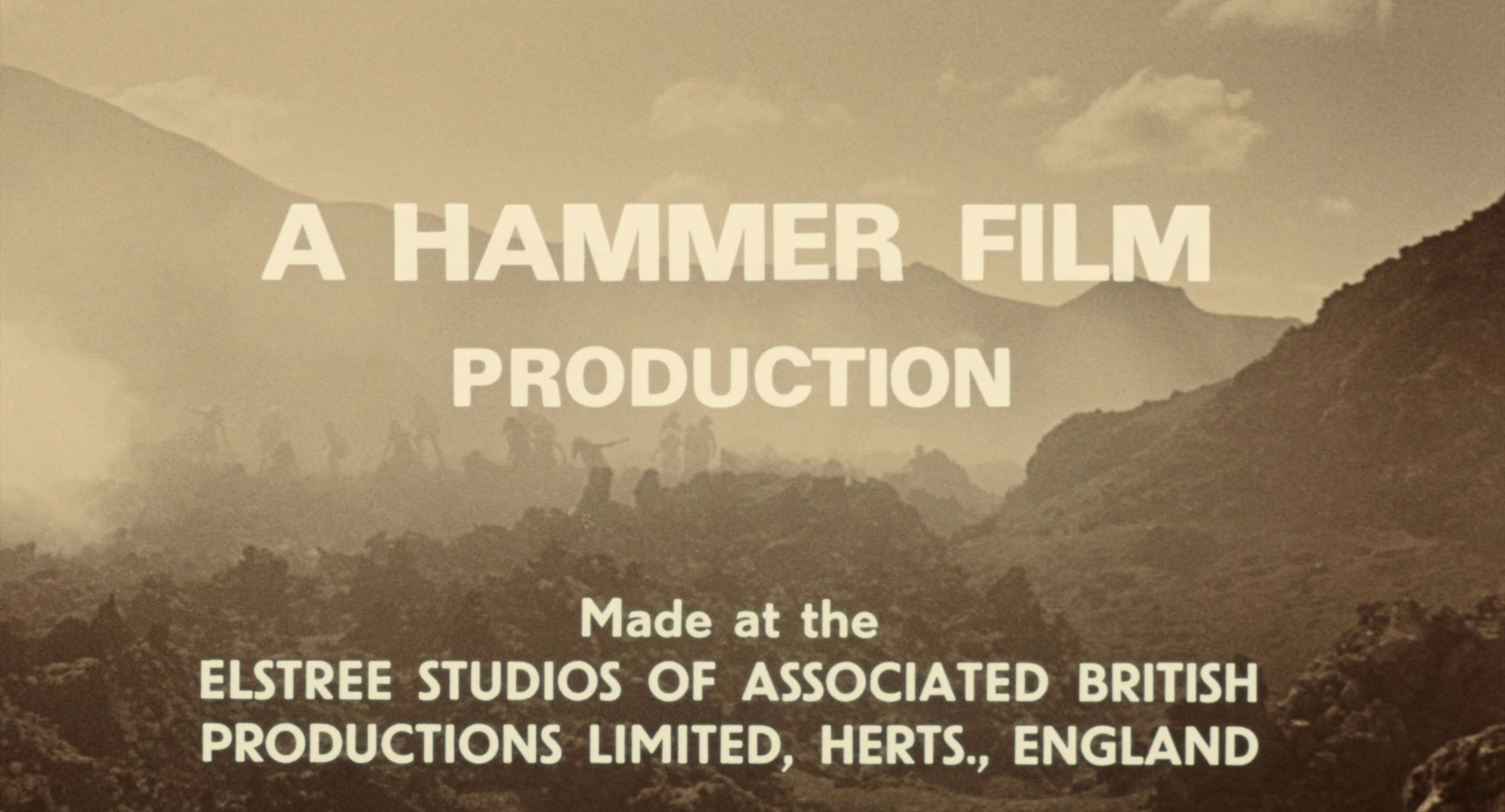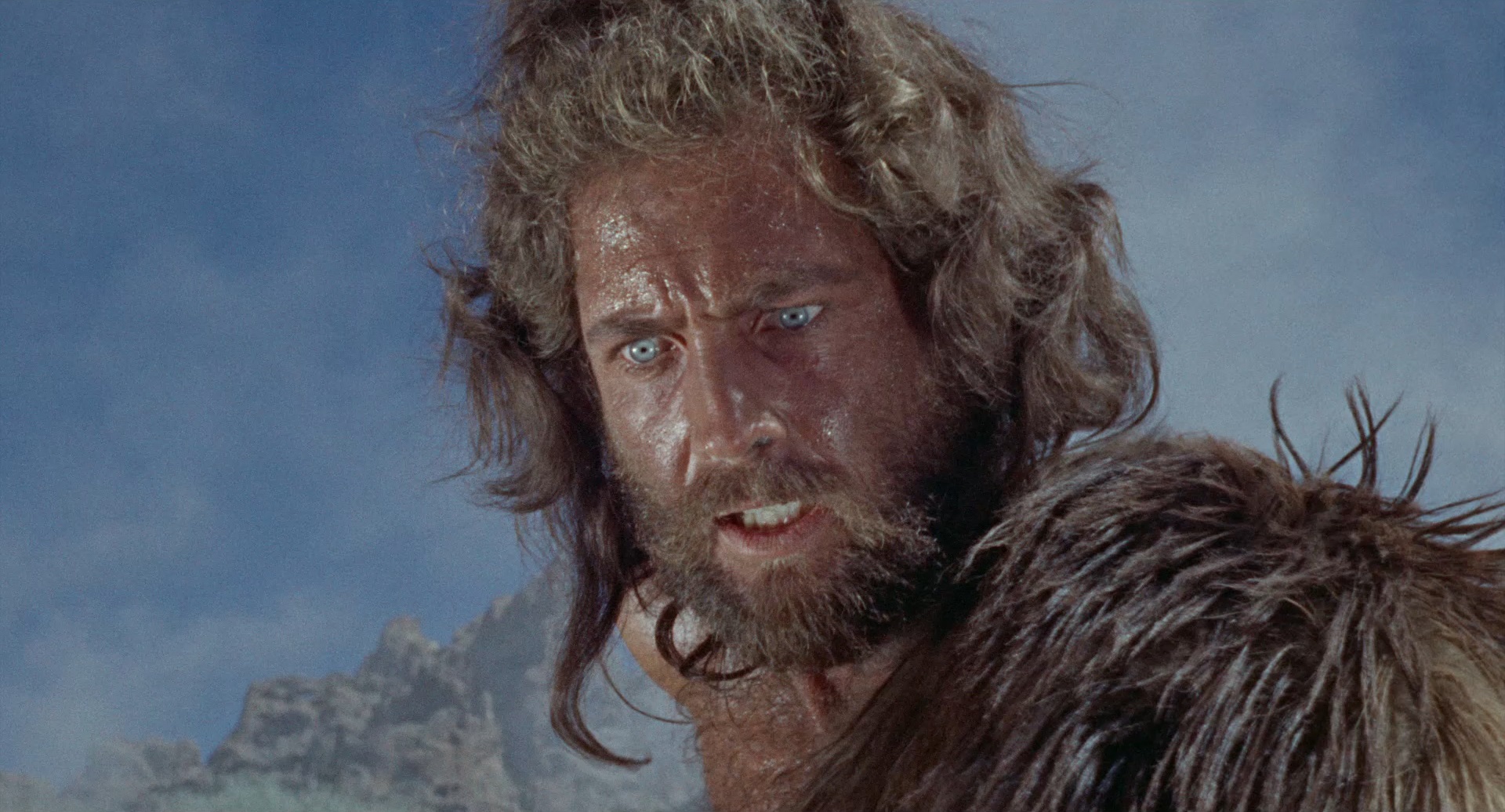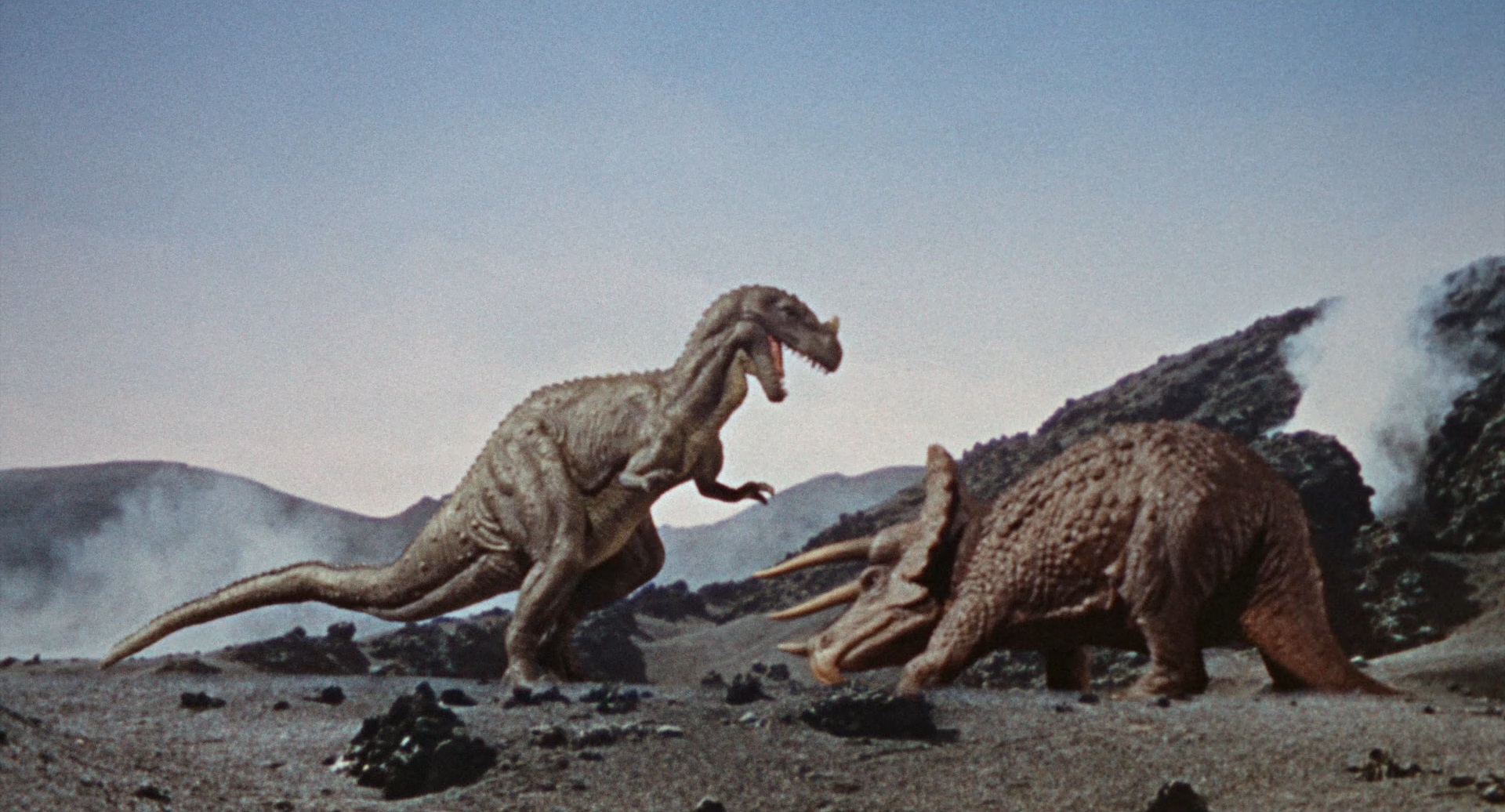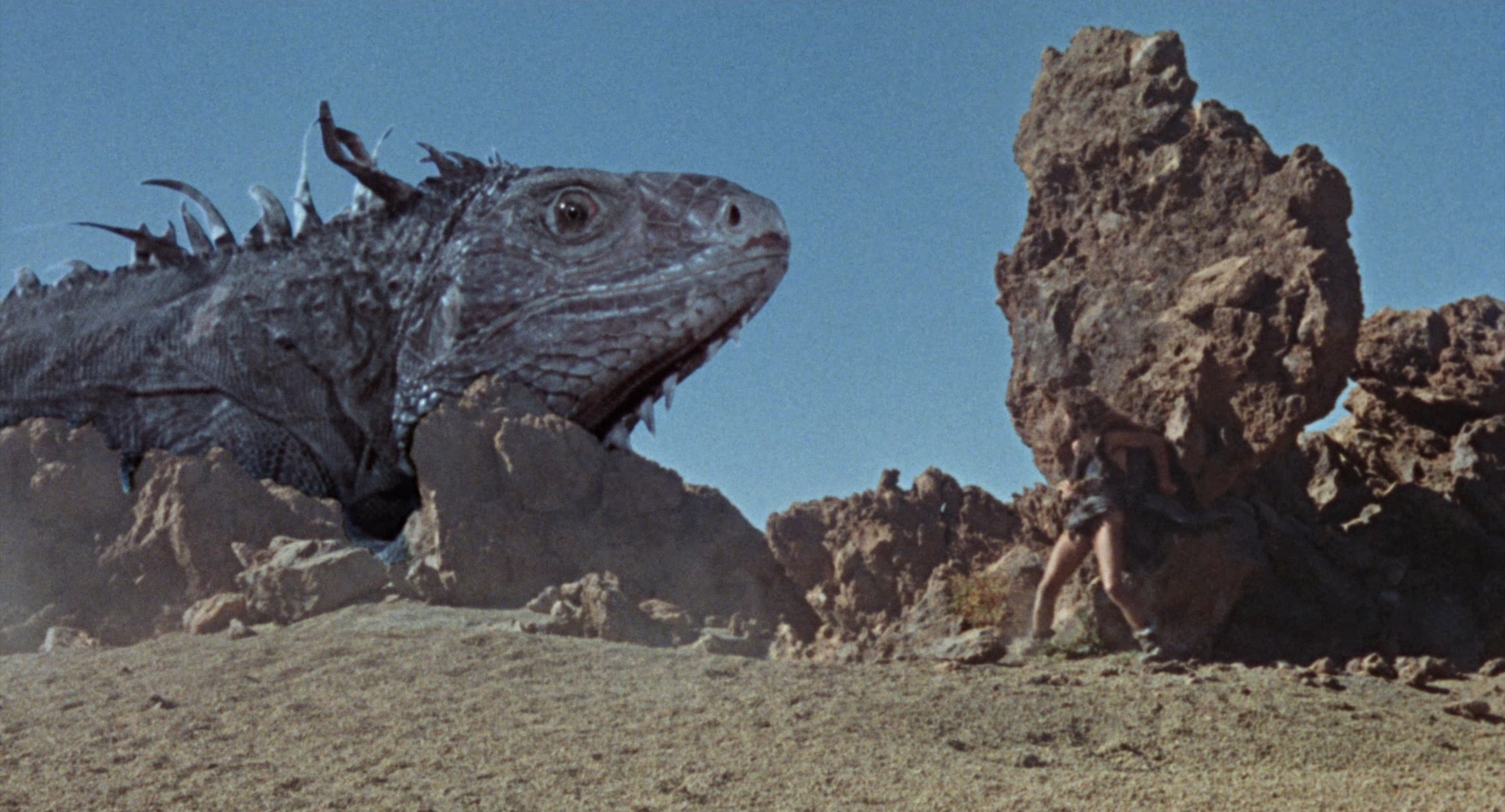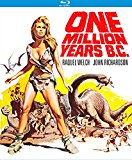| Reviews & Columns |
|
Reviews DVD TV on DVD Blu-ray 4K UHD International DVDs In Theaters Reviews by Studio Video Games Features Collector Series DVDs Easter Egg Database Interviews DVD Talk Radio Feature Articles Columns Anime Talk DVD Savant Horror DVDs The M.O.D. Squad Art House HD Talk Silent DVD
|
DVD Talk Forum |
|
|
| Resources |
|
DVD Price Search Customer Service #'s RCE Info Links |
|
Columns
|
|
|
One Million Years B.C.
Kino // Unrated // February 14, 2017
List Price: $29.95 [Buy now and save at Amazon]
In what few proper sentences there are to be had throughout One Million Years B.C., the narrator refers to this band of primal savages as the Rock Tribe. On one hand, that's as fitting a description as any. They hold dominion over this stark, desolate landscape borne of volcanic rock. The men are as hard as stone. The strong seize whatever they desire, women and the elderly snatch what scraps are dropped along the way, and the weak and infirmed are left for dead. They lack even the most rudimentary language, speaking instead through shows of force. Though the narrator refers to them as a tribe, that concept would be altogether lost on the Rock people. They don't recognize themselves as one group of many. The Rock Tribe is so consumed by dominance and survival that it never occurs to them that they may be anyone else out there. They're scarcely removed from the beasts they hunt. Family is an all but alien concept. Father, brother, son: they're just another obstacle to one's power. Cruel despot Akhoba (Robert Brown) doesn't pay a second thought to battling his son Tumak (John Richardson) to the death, sending him tumbling off a toweringly high cliff with no chance of survival dreamt possible. Tumak's all-but-certain demise allows his scheming brother Sakana (Percy Herbert) to inch another step closer towards ultimate rule over the Rock Tribe.
Tumak yet lives. Cast out, he journeys as no member of his tribe ever had: through searing deserts, past colossal beasts, and just out of sight from troglodytes more primal still. As he collapses, Tumak witnesses an even more impossible sight: people. The Shell Tribe are as close to civilization as this young Earth has known. They laugh. They love. They teach. They learn. They have something close enough to a language, even if it's largely limited to single word commands. They take care of one another, finding strength in their unity. They acknowledge manners and respect. They farm. They're warriors in their own right, crafting spears and gigs that stand in quite literally sharp contrast to the Rock Tribe's sticks and stones. When Loana (Raquel Welch) sees the cracked, sunweathered face of Tumak off in the distance, she and her sisters immediately take him to their village to recover. The children may snicker at the state of his clothing and the uncouth way in which he shovels food into his mouth, but they stop laughing when Tumak saves one of their own from a rampaging Allosaurus. Old habits die hard, however, and Tumak soon finds himself cast out of another tribe. With loyal Loana by his side, he's left with nowhere to return to except the only other home he's ever known. The Rock Tribe has changed profoundly since Tumak was ousted, but so too has he...
Though it's certainly most fondly remembered for Ray Harryhausen's stop-motion animated dinosaurs and for Raquel Welch's bosom-baring leather bikini, there's quite a bit more to One Million Years B.C. than those surface thrills. This is a story told almost entirely without dialogue. The Rock Tribe speaks in grunts, gestures, and the occasional barking of someone's name. The Shell Tribe is advanced enough to have somewhat of a vocabulary, though it's largely limited to single commands. Once the film is underway, it refuses to lean on narration as a crutch. The performances convey what dialogue cannot, often in subtle ways. Something as simple as one of the Shell Tribe's elders holding up his hand in quiet disapproval when the children laugh at Tumak's feral manner of eating speaks volumes about their society. There is an unmistakeable soulfulness behind Tumak's piercing blue eyes that hint at the man that he is. His growth as a character -- defending the helpless, falling in love, stepping up as a leader -- following a lifetime of tribally obligated selfishness is deeply felt. As quickly as thoughts of One Million Years B.C. may quickly turn to cleavage, its gender politics are at least a bit more thoughtful than one might expect. Indeed, Tumak is only guided towards heroism because of the light shone by Loana. As kind and devoted as she is, Loana is no damsel in distress, defeating a more seasoned warrior in battle. Even when she's snatched by a Pterodactyl, she is not rescued. Loana has more than earned her prominent placement on One Million Years B.C.'s iconic poster art; she may not be lavished with the most screentime, but it's readily argued that she's the film's most pivotal character.
Even in the extended international cut of One Million Years B.C., this is a story that unfolds briskly. Although there are messages about the building and defining natures of society, it's still very much a thrilling adventure at heart. Ray Harryhausen's unparalleled talents as an artist and animator bring to life a colossal sea turtle, a Brontosaurus, an Allosaurus, a battling Ceratosaurus and Triceratops, multiple pterosaurs, and -- why not? -- a giant spider. As is invariably the case with Harryhausen's work, these aren't simply effects; they're living, breathing creatures. Fifty years later, I still gawk at what he's brought to life and am astonished at how this was executed at all, let alone by one man. Beyond Harryhausen's animation, a seemingly idyllic underground oasis is home to scores of feral troglodytes; that they're in a sort of pit brings to mind another genre film. There is no shortage of skillfully staged battles among people as well. One Million Years B.C. benefits further from the seasoned eye of cinematographer Wilkie Cooper, a longtime collaborator of Harryhausen's. Its use of the Canary Islands ensures that the film looks as if it was shot in a stark, primal world long since lost. A great many people sneer at One Million Years B.C. as juvenile tits-and-dinosaurs, and while the film most certainly delivers on that front, there's a genuinely enjoyable movie worth appreciating beyond that. Highly Recommended, especially with this terrific special edition that Kino Lorber Studio Classics has put together.
Video
Both the extended international and heavily trimmed U.S. versions of One Million Years B.C. have been lovingly remastered in 4K, with Kino Lorber Studio Classics presenting each cut on a disc of its own. More specifically, it appears that the international release was restored, and all the necessary snips and cuts were made afterwards to recreate the American version. The shared footage in the two presentations is, for all intents and purposes, identical:
No difference in quality marks the moments unique to the international cut. The U.S. version is simply trimmed down, with only the credits boasting any material that isn't present in the extended release. It's not surprising, then, that the American credits look softer and duller than their British equivalents, but those are really the only variances worth highlighting:
Kino's release easily ranks among the best looking of Ray Harryhausen's films on Blu-ray, perhaps second only to First Men on the Moon. The revitalized palette looks marvelous, even given the constraints of this stark, primal environment. I'm thrilled by the clarity and detail so consistently on display here, with the caveat that the image unavoidably degrades somewhat in optical and effect shots. Both presentations are immaculate, and these discs have been authored with a filmic eye. From a traditional viewing distance, I'm not left with any concerns about compression artifacts or the like. Simply extraordinary.
Both cuts of One Million Years B.C. are presented at an aspect ratio of 1.85:1. This is a two-disc set, with each version presented on its own BD-50 disc.
Audio
Much the same as One Million Years B.C.'s visuals, I couldn't discern any difference between the 16-bit DTS-HD Master Audio soundtracks across these two different cuts of the film. The very brief narration at the outset is wonderfully clean and clear, and what little dialogue follows -- single word imperatives in what passed for a language a movie-megennium ago -- is adeptly rendered. The colossal beasts' footsteps and roars are reinforced in the lower frequencies appropriately for a film that recently celebrated its fiftieth anniversary. There's no background noise to speak of at all, and the lossless audio isn't marred by any sibilance or so much as a flicker of distortion. I'll confess that my initial reaction was more lukewarm, but the more I listened and the more I increased the volume, the more impressed I found myself.
Tim Lucas' commentary aside, there are no other audio options.
Extras
One Million Years B.C.'s extras are divided across both of the discs in this set.
International Cut
U.S. Cut
I can't say that I understand why there's a spread of Raquel Welch's Loana being crucified on the inner art or what motivated that photo to be snapped in the first place -- nothing remotely close to that occurs in the film itself -- but it's certainly interesting.
Missing from this release compared to the recent StudioCanal special edition in the UK are a more recent interview with Raquel Welch and storyboards/notes for the unfilmed Brontosaurus attack.
The Final Word
One Million Years B.C. has been a fixture on countless Blu-ray wish lists for more than a decade now, and Kino Lorber Studio Classics has ensured that this release has been well-worth the wait. Boasting some of the most iconic animation in Ray Harryhausen's storied career, its visual spectacle is only heightened by this exceptional 4K remaster. Raquel Welch may groan at One Million Years B.C. as an embarrassment to live down, but I found the film to hold up marvelously these many decades later. Although a more extensive selection of extras would've been appreciated, I still very much enjoyed what's been offered here. Highly Recommended.
Tumak yet lives. Cast out, he journeys as no member of his tribe ever had: through searing deserts, past colossal beasts, and just out of sight from troglodytes more primal still. As he collapses, Tumak witnesses an even more impossible sight: people. The Shell Tribe are as close to civilization as this young Earth has known. They laugh. They love. They teach. They learn. They have something close enough to a language, even if it's largely limited to single word commands. They take care of one another, finding strength in their unity. They acknowledge manners and respect. They farm. They're warriors in their own right, crafting spears and gigs that stand in quite literally sharp contrast to the Rock Tribe's sticks and stones. When Loana (Raquel Welch) sees the cracked, sunweathered face of Tumak off in the distance, she and her sisters immediately take him to their village to recover. The children may snicker at the state of his clothing and the uncouth way in which he shovels food into his mouth, but they stop laughing when Tumak saves one of their own from a rampaging Allosaurus. Old habits die hard, however, and Tumak soon finds himself cast out of another tribe. With loyal Loana by his side, he's left with nowhere to return to except the only other home he's ever known. The Rock Tribe has changed profoundly since Tumak was ousted, but so too has he...
Though it's certainly most fondly remembered for Ray Harryhausen's stop-motion animated dinosaurs and for Raquel Welch's bosom-baring leather bikini, there's quite a bit more to One Million Years B.C. than those surface thrills. This is a story told almost entirely without dialogue. The Rock Tribe speaks in grunts, gestures, and the occasional barking of someone's name. The Shell Tribe is advanced enough to have somewhat of a vocabulary, though it's largely limited to single commands. Once the film is underway, it refuses to lean on narration as a crutch. The performances convey what dialogue cannot, often in subtle ways. Something as simple as one of the Shell Tribe's elders holding up his hand in quiet disapproval when the children laugh at Tumak's feral manner of eating speaks volumes about their society. There is an unmistakeable soulfulness behind Tumak's piercing blue eyes that hint at the man that he is. His growth as a character -- defending the helpless, falling in love, stepping up as a leader -- following a lifetime of tribally obligated selfishness is deeply felt. As quickly as thoughts of One Million Years B.C. may quickly turn to cleavage, its gender politics are at least a bit more thoughtful than one might expect. Indeed, Tumak is only guided towards heroism because of the light shone by Loana. As kind and devoted as she is, Loana is no damsel in distress, defeating a more seasoned warrior in battle. Even when she's snatched by a Pterodactyl, she is not rescued. Loana has more than earned her prominent placement on One Million Years B.C.'s iconic poster art; she may not be lavished with the most screentime, but it's readily argued that she's the film's most pivotal character.
Even in the extended international cut of One Million Years B.C., this is a story that unfolds briskly. Although there are messages about the building and defining natures of society, it's still very much a thrilling adventure at heart. Ray Harryhausen's unparalleled talents as an artist and animator bring to life a colossal sea turtle, a Brontosaurus, an Allosaurus, a battling Ceratosaurus and Triceratops, multiple pterosaurs, and -- why not? -- a giant spider. As is invariably the case with Harryhausen's work, these aren't simply effects; they're living, breathing creatures. Fifty years later, I still gawk at what he's brought to life and am astonished at how this was executed at all, let alone by one man. Beyond Harryhausen's animation, a seemingly idyllic underground oasis is home to scores of feral troglodytes; that they're in a sort of pit brings to mind another genre film. There is no shortage of skillfully staged battles among people as well. One Million Years B.C. benefits further from the seasoned eye of cinematographer Wilkie Cooper, a longtime collaborator of Harryhausen's. Its use of the Canary Islands ensures that the film looks as if it was shot in a stark, primal world long since lost. A great many people sneer at One Million Years B.C. as juvenile tits-and-dinosaurs, and while the film most certainly delivers on that front, there's a genuinely enjoyable movie worth appreciating beyond that. Highly Recommended, especially with this terrific special edition that Kino Lorber Studio Classics has put together.
Video
Both the extended international and heavily trimmed U.S. versions of One Million Years B.C. have been lovingly remastered in 4K, with Kino Lorber Studio Classics presenting each cut on a disc of its own. More specifically, it appears that the international release was restored, and all the necessary snips and cuts were made afterwards to recreate the American version. The shared footage in the two presentations is, for all intents and purposes, identical:
No difference in quality marks the moments unique to the international cut. The U.S. version is simply trimmed down, with only the credits boasting any material that isn't present in the extended release. It's not surprising, then, that the American credits look softer and duller than their British equivalents, but those are really the only variances worth highlighting:
Kino's release easily ranks among the best looking of Ray Harryhausen's films on Blu-ray, perhaps second only to First Men on the Moon. The revitalized palette looks marvelous, even given the constraints of this stark, primal environment. I'm thrilled by the clarity and detail so consistently on display here, with the caveat that the image unavoidably degrades somewhat in optical and effect shots. Both presentations are immaculate, and these discs have been authored with a filmic eye. From a traditional viewing distance, I'm not left with any concerns about compression artifacts or the like. Simply extraordinary.
Both cuts of One Million Years B.C. are presented at an aspect ratio of 1.85:1. This is a two-disc set, with each version presented on its own BD-50 disc.
Audio
Much the same as One Million Years B.C.'s visuals, I couldn't discern any difference between the 16-bit DTS-HD Master Audio soundtracks across these two different cuts of the film. The very brief narration at the outset is wonderfully clean and clear, and what little dialogue follows -- single word imperatives in what passed for a language a movie-megennium ago -- is adeptly rendered. The colossal beasts' footsteps and roars are reinforced in the lower frequencies appropriately for a film that recently celebrated its fiftieth anniversary. There's no background noise to speak of at all, and the lossless audio isn't marred by any sibilance or so much as a flicker of distortion. I'll confess that my initial reaction was more lukewarm, but the more I listened and the more I increased the volume, the more impressed I found myself.
Tim Lucas' commentary aside, there are no other audio options.
Extras
One Million Years B.C.'s extras are divided across both of the discs in this set.
International Cut
- Audio Commentary: Tim Lucas' commentary isn't as startlingly expansive as I've come to expect, but it's a deeply rewarding listen just the same. As ever, Lucas excels at providing the proper context, delving into the lives and careers of seemingly everyone on both sides of the camera, and he delights in noting when specifically Harryhausen animated each of his standout sequences. He also offers a terrific analysis of the film's gender and social dynamics, highlighting nuances that I hadn't fully appreciated prior to listening to this commentary. Lucas delves into the many sequences truncated in the U.S. release that are presented in full here. Among the other highlights are noting that Raquel Welch's sparse dialogue was entirely dubbed, John Richardson and Martine Beswick being promised to one another on-screen and off, why Harryhausen's 'Dynamation' didn't make it into any of the press materials, the constant attention that leather skivvies require (especially when splashing around in the water!), and Harryhausen's regret at using a live iguana for the first dinosaur encounter.
- Animated Montage of Posters and Images (3 min.; HD): As its lengthy label on the menu suggests, this montage showcases very different poster art from all across the globe as well as production stills in both color and black & white. These very high resolution scans look stunning.
- Original International Theatrical Trailer (3 min.; SD): The international trailer is presented in dreadful sub-YouTube quality.
U.S. Cut
- The American Version of One Million Years B.C. (91 min.; HD): Honestly, I think of this heavily edited cut as being more of an extra than anything else. As Tim Lucas notes in his commentary, Fox was targeting a younger audience for the American release, gutting the more lurid material out of the film. All but one of the sequences featuring Harryhausen's animation are trimmed down, as unfathomable as that may be. Among the other truncated sequences are a fatal battle between two troglodytes and its grisly aftermath, Nupondi's frenzied mating dance, and Tumak's painful removal of a prehistoric boar's tusk. The clumsy attempts at accelerating the pace mute the character growth and relationships that are far more pronounced in the international cut. Nostalgia aside, I can't really imagine this being anyone's preferred version of the film.
- Archival Interviews (20 min.; SD): Blue Underground's interviews with Raquel Welch and Ray Harryhausen from the fifteen year old UK DVD release have both been carried over here. Welch was nearly as embarrassed by One Million Years B.C. when this interview was conducted in 2002 as she was before filming began, only onboard for a taste of Swinging London and contractual obligation. She notes what a grueling shoot it was, from a near-fatal bout of tonsilitis in the punishing cold to director Don Chaffey scoffing whenever Welch wanted to add any dimension to her performance. Welch also chats about how much she loved doing catfights, rightly marvels at Harryhausen's brillance, and, of course, discusses how profoundly that poster changed the course of her life.
The interview with the since-departed Ray Harryhausen opens with a very brief primer into his career in animation up to the mid-'60s. From there, it's one exceptional story after another: his first meeting with Hammer Films (including a note about the movie's precise budget!), the iguana falling asleep under the hot studio lights and practically having to be manipulated like a hand puppet, and the man-eating Brontosaurus on the poster originally being intended to appear late in the film. Harryhausen illustrates stop motion techniques with several of the models actually used in One Million Years B.C., although all that remains of the triceratops is a mounted head. Also offered here are brief looks at storyboards and production stills.
- Interview with Martine Beswick (17 min.; HD): This newly produced interview leads with Beswick reflecting on how she fell into acting and her longer-than-average stint as a Bond girl -- one so memorable that she didn't even have to audition for One Million Years B.C., instead being offered the role of Nupondi outright. It's a far more enthusiastic interview than Raquel Welch's, as Beswick gushes over how much she loved working in the almost otherworldly Canary Islands (punishing weather and all), agreeing with Welch to shoot the big catfight themselves rather than settle for wildly unconvincing body doubles, ripping off fistfuls of indescribably hot meat from a roasted pig, and how she was so awestruck by John Richardson that she tried to avoid being a part of the film altogether, knowing that being around him would transform her life. Beswick also speaks about how much she adored working with Harryhausen and what it was like to react to essentially nothing when filming her parts of the effect sequences.
- Original U.S. Theatrical Trailer (3 min.; SD): Though still presented in standard definition, the domestic trailer looks immeasurably better than its international equivalent on the other disc.
I can't say that I understand why there's a spread of Raquel Welch's Loana being crucified on the inner art or what motivated that photo to be snapped in the first place -- nothing remotely close to that occurs in the film itself -- but it's certainly interesting.
Missing from this release compared to the recent StudioCanal special edition in the UK are a more recent interview with Raquel Welch and storyboards/notes for the unfilmed Brontosaurus attack.
The Final Word
One Million Years B.C. has been a fixture on countless Blu-ray wish lists for more than a decade now, and Kino Lorber Studio Classics has ensured that this release has been well-worth the wait. Boasting some of the most iconic animation in Ray Harryhausen's storied career, its visual spectacle is only heightened by this exceptional 4K remaster. Raquel Welch may groan at One Million Years B.C. as an embarrassment to live down, but I found the film to hold up marvelously these many decades later. Although a more extensive selection of extras would've been appreciated, I still very much enjoyed what's been offered here. Highly Recommended.
|
| Popular Reviews |
| Sponsored Links |
|
|
| Sponsored Links |
|
|
| Release List | Reviews | Shop | Newsletter | Forum | DVD Giveaways | Blu-Ray | Advertise |
|
Copyright 2024 DVDTalk.com All Rights Reserved. Legal Info, Privacy Policy, Terms of Use,
Manage Preferences,
Your Privacy Choices | |||||||









